Photoelectron momentum distributions of Ne and Xe dimers in counter-rotating circularly polarized laser fields
2022-06-29ZhiXianLei雷志仙QingYunXu徐清芸ZhiJieYang杨志杰YongLinHe何永林andJingGuo郭静
Zhi-Xian Lei(雷志仙), Qing-Yun Xu(徐清芸), Zhi-Jie Yang(杨志杰), Yong-Lin He(何永林), and Jing Guo(郭静)
Institute of Atomic and Molecular Physics,Jilin University,Changchun 130012,China
Keywords: time-dependent Schr¨odinger equation, dimer, photoelectron momentum distributions, ultrafast photoionization model
1. Introduction
Rapid developments in advanced laser technology provide new tools for investigating electron dynamics on its natural attosecond time scale(1 as=10-18s).[1–3]The interaction of laser pulses with atoms and molecules has become a hot topic in strong-field physics.[4]Ultrafast imaging of molecules with femtosecond temporal and sub-Angstrom spatial resolutions has emerged due to the development of x-ray free electron lasers.[5–11]
The ionization is one of the basic processes in strongfield physics. The ionized electron wave packets can produce various high-order nonlinear strong-field physical phenomena, such as multiphoton ionization,[12]abovethreshold ionization,[13,14]high-order harmonic generation(HHG),[15,16]and nonsequential double ionization.[17,18]Observing the ionization dynamics of atoms and molecules under the intense laser fields and tracking them on the attosecond time scale can help us understand the motion of ionized electrons better. The photoelectron momentum distributions(PMDs) and photoelectron angular distributions (PADs) of atoms and molecules contain valuable information about the electron dynamics,which have attracted great attention of researchers over the past few years.[19–21]Besides,they are also important for detecting electron dynamics and the structure of atoms and molecules.
In recent years, the photoionization processes have been investigated in elliptically[22,23]and circularly polarized laser fields.[24,25]In 2016,Yuanet al.[21]theoretically explored the PMDs of hydrogen molecular ion by bichromatic circularly polarized pulses, which illustrates that the PMDs are sensitive to the molecular alignment and the parameters of the bichromatic co- and counter-rotating pulses. A pair of elliptically polarized laser pulses were used to investigate the role of initial states in photoelectron momentum distributions for Ne atom.[26]The interference effect of two emission centers for diatomic molecules on strong-field ionization (SFI)has attracted great attention, which has been suggested in 1966,[27]and then it was modeled in the photoionization of H2and H+2.[28]Nowadays it has been extended from perturbative regime to nonperturbative regime.[29]The influence of such interference effect on photoionization processes has been investigated for N2, O2, S2, and F2[30–33]with different initial states. The PMDs and PADs of N2and O2and their companion atoms(atoms with comparable ionization potentials) Ar and Xe, which were investigated experimentally and theoretically,[34]indicated that the influence of the parity of molecular HOMOs on the strong field molecular ionization dynamics. Recently, strong-field ionization (SFI) of the homonuclear noble gas dimer Ne2[35]was investigated experimentally, which clearly showed an interference pattern in both circularly and linearly polarized laser fields and proved that two-center interference exists in Ne dimer. Then theoretical research[36]indicated the influence of double-slit interference on laser-induced dimer diffraction, and it also presented the dependence of the double-slit interference structure on the symmetry of the dimer orbitals and dimer orientation.
In the present work,we theoretically investigate the photoionization of Ne and Xe dimers by bichromatic (ω1=ω2)counter-rotating circularly polarized laser fields with different time delays. The PMDs and PADs are dependent on the time delays,which derived from the interference between coherent electron wave packets emanating from the two nuclear centers. The ultrafast photoionization model[29]and the evolution of the electron wave packets are used to explain these results. Besides,we also compare the PMDs of Ne dimer with Ne atom and found that there are vortex patterns in the PMDs of Ne atom. The paper is arranged as follows: The theoretical model and computational methods are described in Section 2.The PMDs and PADs with different time delays of Ne and Xe dimers, and the differences between the PMDs of Ne dimer and Ne atom are presented and discussed in Section 3.Finally,we summarize our results in Section 4. Throughout this paper,atomic units(a.u.)e= ¯h=me=1 are used unless otherwise stated.
2. Theoretical model and computational methods
We investigate the ionization of Ne and Xe dimers in counter-rotating circularly polarized laser pulses. As illustrated in Fig. 1(a), the Ne and Xe dimers are oriented in the(x,y)plane and are aligned alongxaxis. The two-dimensional(2D)time-dependent Schr¨odinger equation(TDSE)for dimers can be expressed as follows:
Herer= (x,y) denotes the electron coordinate inx–yplane andαlabels the nuclei located at fixed positionsRα. The effective nuclear chargeZ∞and the bare chargeZ0are 0.5 and 10, respectively. The softcore parameterais chosen to avoid singularity andσis effective charge shielding parameter. The Ne dimer(Ne2) has a ground-state molecular orbital configuration of(1sσg)2(1sσu)2(2sσg)2(2sσu)2(2pσg)2(2pπu)4(2pπg)4(2pσu)2.For the 2pσgorbital,a=1.200 andσ=0.815.[36]The internuclear distance|R|=|R1-R2|=5.86 a.u. for Ne2, and the ionization potential of the ground state isIp=0.747 a.u.[37]
For Xe dimer, the molecular orbital configuration is···(5sσg)2(5sσu)2(5pσg)2(5pπu)4(5pπg)4(5pσu)2,[38]and the soft-core Coulomb potential can be written as

where the analytical expression ofZβ(rβ) has the following form:

rβ=r-Rβis the distance between the electron and the nucleus,Rβ=±R(Xe-Xe)/2 is position of the nucleus and the internuclear distance isR(Xe-Xe)=8.35 a.u.,ρβ=9.2, andσβ=0.5 are chosen to meet the ionization potential of the ground state,i.e.,Ip=0.44 a.u.[38]
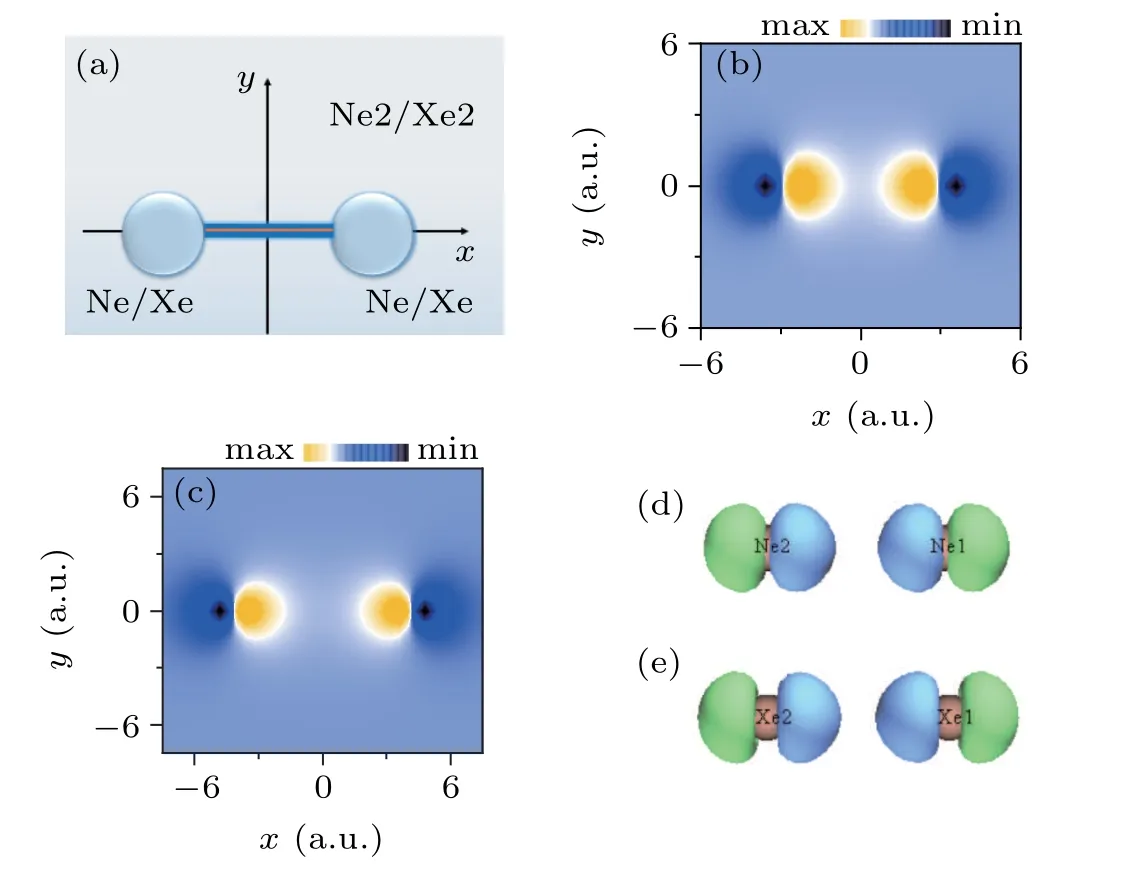
Fig.1. (a)Ne and Xe dimers are oriented in the(x,y)plane,R is the distance between two nucleus. Panels(b)and(c)are the wave functions of 2pσg orbital for Ne dimer and 5pσg orbital for Xe dimer. Panels(d)and(e)are the wave functions of Ne dimer and Xe dimer obtained by GAUSSIAN09.
The interaction between dimers and the laser pulse isVL(r,t)=r·E(t),E(t)is the electric field of counter-rotating circularly polarized pulses with time delayTd, which can be expressed as
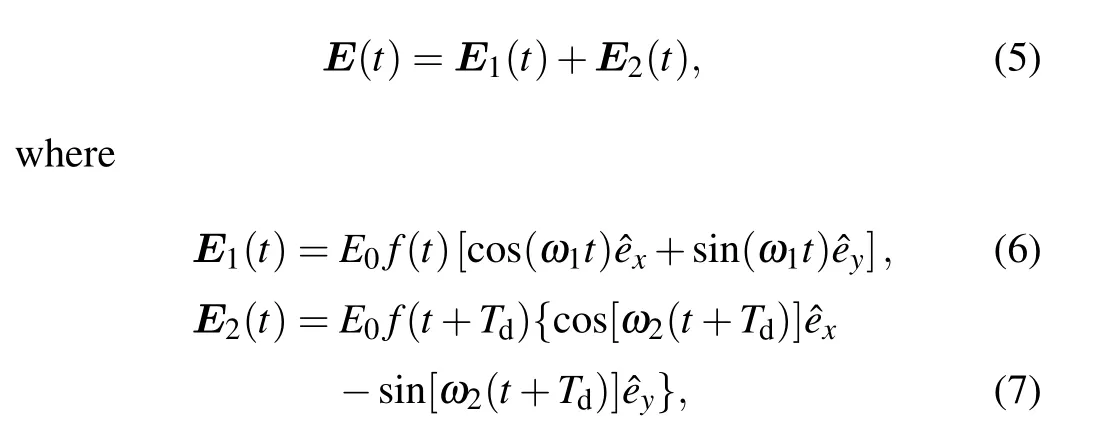
whereE0=0.107 a.u. (I0=4×1014W/cm2) is the amplitude of the electric fields. ˆex/yis the laser polarization direction,ω1/2(ω1=ω2) is the angular frequency of laser fields, and theTdis the time delay between two pulses. The pulse duration isT=20T0(T0=2π/ω1), and the pulse envelopef(t) = exp[-2(ln2)t2/τ2] is used withτ= 2T0. In our calculation,the pulse duration isT=20T0(T0=2π/ω1),for Ne dimerT ≈44 fs (ω1= 1.4 a.u.) and for Xe dimerT ≈78 fs (ω′1=0.78 a.u.). According to supplemental material of Ref. [35], we can learn that for Ne dimer the time required to reach an internuclear distance of 10 °A during direct dissociation starting at an internuclear distance of 3.1 °A is 600 fs–700 fs, while the indirect dissociation happens faster:an internuclear distance of 10 °A is reached within 200 fs–300 fs. Since the Xe and Ne are both noble gases,we believe that the time required for dissociation of Xe and Ne dimers are similar. Therefore,the dissociation for both dimers will not be taken into account in this paper.
The 2D TDSE can be solved by fast Fourier transform technique combined with split-operator method.[39,40]The imaginary-time propagation method has been used to obtain the initial wavefunction of Ne and Xe dimers. The wave functions for molecular ground state of Ne and Xe dimers are shown in Figs.1(b)and 1(c). We can see that the two dimers are located along the molecularRaxis with theσgsymmetry.The ground state orbitals of Ne and Xe dimers are obtained by using the Hartree–Fock method with the 6-31+g (d,p)basis set as implemented in the GAUSSIAN09 program,[41]the results are shown in Figs. 1(d) and 1(e). Obviously they match the results obtained by the imaginary-time propagation method shown in Figs. 1(b) and 1(c), which also proves the correctness of our theoretical model.
The second-order split-operator method is used in our calculation to obtain the propagation of wave function,
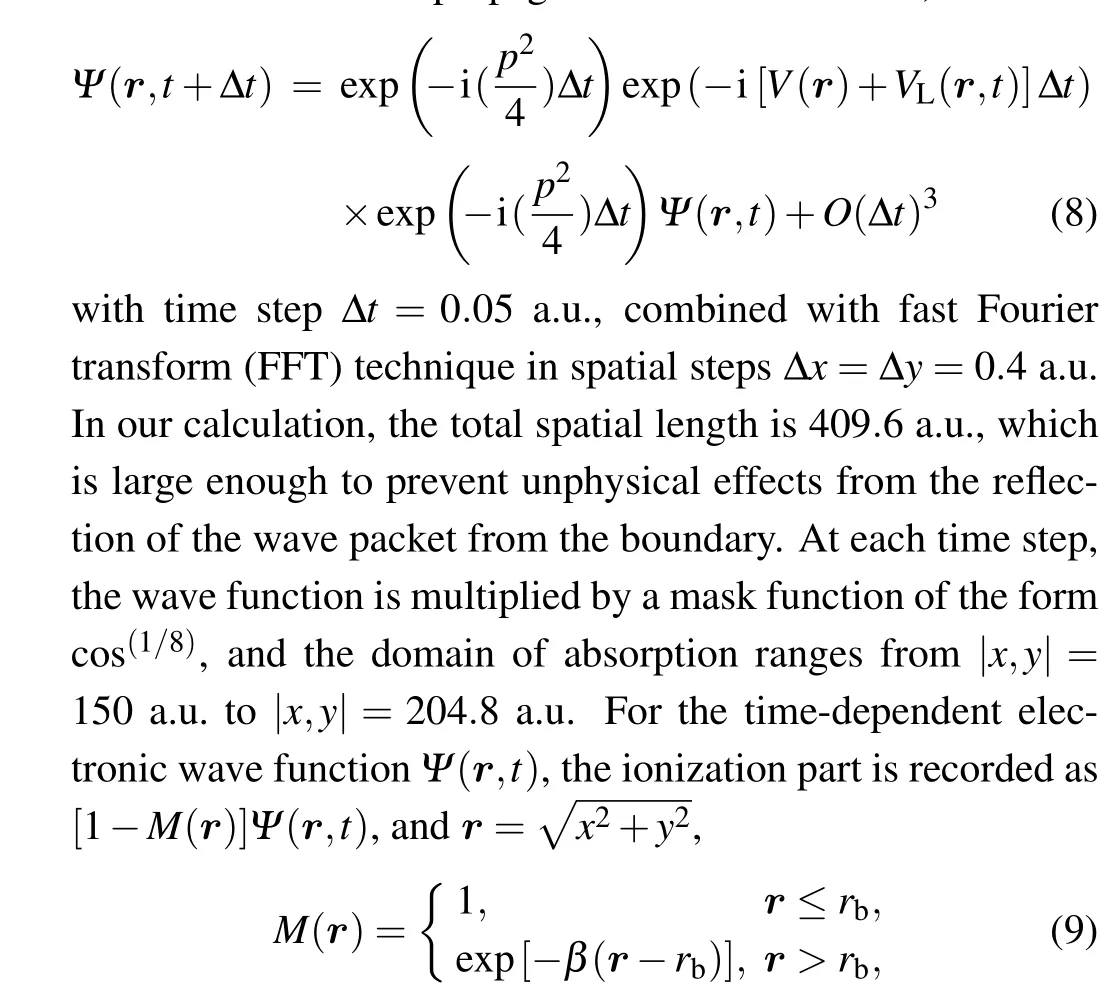
whereβ= 1, and the boundary for ionized electron wave function and bounded wave function is set to berb=80 a.u.The photoelectron momentum distributions are acquired by Fourier transforming the ionized electron wave function into momentum space, the photoelectron angular distributions are obtained from the photoelectron momentum distributions.
3. Results and discussion
In the present work, the photoionization of Ne and Xe dimers by counter-rotating circularly polarized laser pulses

The results can be explained by the ultrafast photoionization model of molecules[29,42]which has been successfully used to explain the two-center ionization process of hydrogen molecular ion. For single-photon ionization process,the transition matrix element can be written as


The term of cosine triangle functions cos(2θ+ω2Td)presents the interference effects of the coherent electron wave packets due to the time delay of counter-rotating circularly polarized laser pulses, sin2[(pRcos(θ))/2]presents the interference effects of the coherent electron wave packets emanating from the two nuclear centers. The results obtained from Eq. (23) are presented in Figs. 3(a)–3(d). By comparing Figs. 2 and 3, we can see that the angles of the radiation peaks of the PADs obtained from TDSE simulations in Fig.2 are consistent with those predicted by the ultrafast ionization model in Fig.3. However,the intensity of predicted results for PMDs in Fig. 3 cannot match the simulated results in Fig. 2 very well. The reason is as follows: the ultrafast ionization model is an oversimplified two-center model and the effects of the molecular Coulomb potential are not taken into account in the model,[43]which results in the intensity of predicted results for PADs cannot agree well with the simulated results.

Fig.2. PMDs and PADs of aligned Ne dimer at equilibrium internuclear distance R(Ne-Ne)=5.86 a.u.by counter-rotating circularly polarized laser pulses at λ1=λ2=32.5 nm(ω1=ω2=1.4 a.u.). The intensity of the laser pulses is I0=4×1014 W/cm2 (E0=0.107 a.u.) and duration is T =20T0 (T0=2π/ω1)with τ =2T0 =2 o.c. The upper row is the PMDs: (a1) Td =0 o.c., (b1) Td =2 o.c., (c1) Td =4 o.c., (d1) Td =6 o.c. The lower row is the PADs: (a2)Td=0 o.c.,(b2)Td=2 o.c.,(c2)Td=4 o.c.,(d2)Td=6 o.c. The unit o.c.is short for optical cycle.
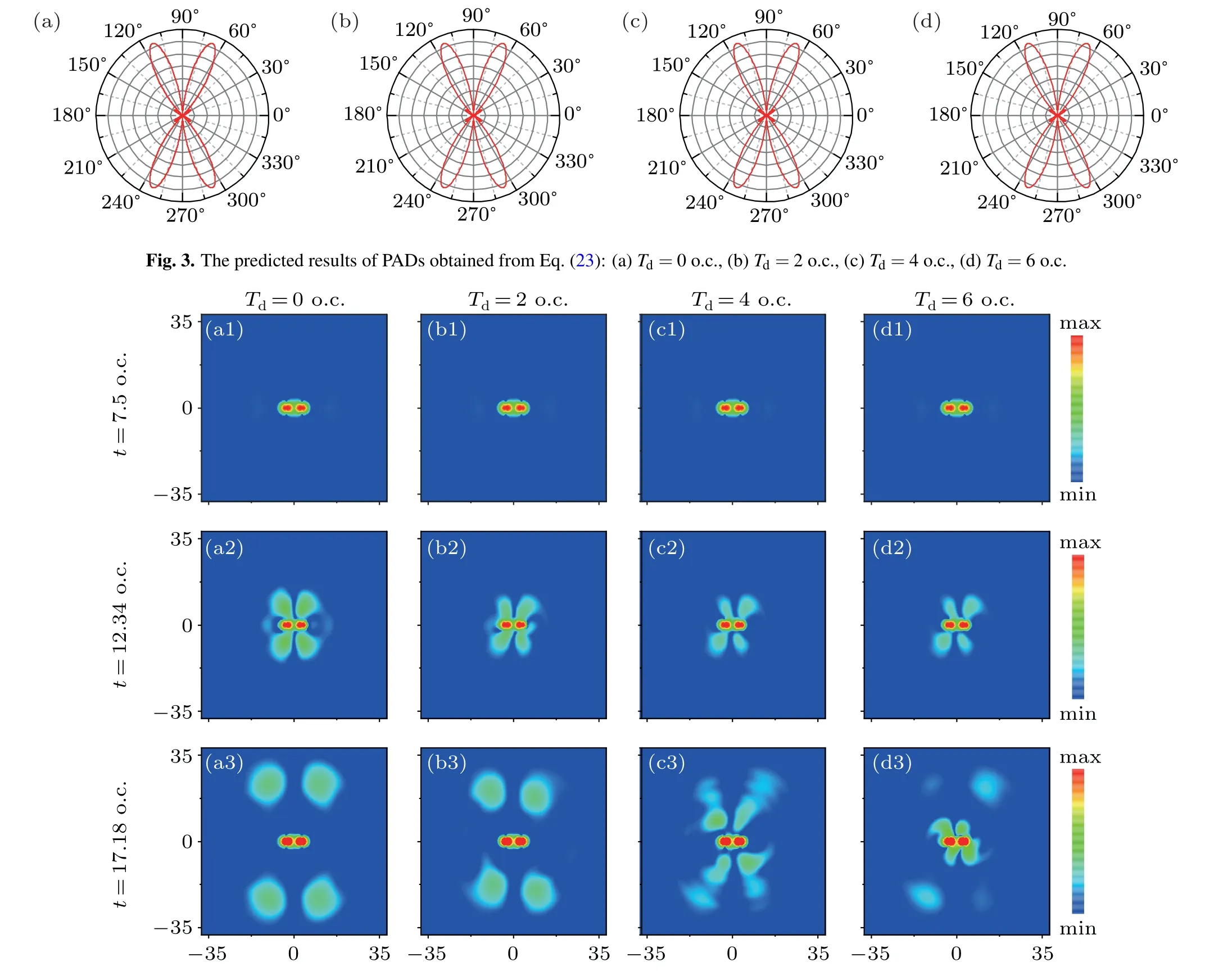
Fig.4. The electron wave packets for the Ne dimer at different times by counter-rotating circularly polarized laser pulses at wavelength λ1=λ2=32.5 nm(ω1=ω2=1.4 a.u.) with four time delays: [(a1)–(a3)]Td=0 o.c.,[(b1)–(b3)]Td=2 o.c.,[(c1)–(c3)]Td=4 o.c.,and[(d1)–(d3)]Td=6 o.c. The results are shown at three different times: [(a1)–(d1)]t=7.5 o.c.,[(a2)–(d2)]t=12.34 o.c.,and[(a3)–(d3)]t=17.18 o.c.
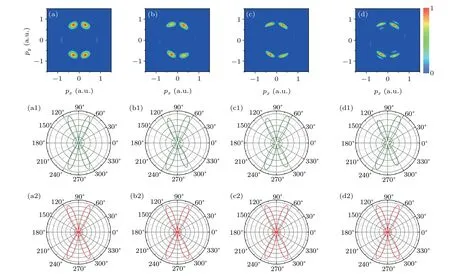
Fig.5. The PMDs and PADs of aligned Xe dimer at equilibrium R(Xe-Xe)=8.35 a.u.by counter-rotating circularly polarized pulses at λ′1=λ′2=58.5 nm(ω′1=ω′2=0.78 a.u.).The intensity of the laser pulses is I0=4×1014 W/cm2(E0=0.107 a.u.)and duration is T =20T0(T0=2π/ω′1)with τ=2T0=2 o.c.The PMDs and PADs simulated by TDSE are shown respectively for different time delays: (a)and(a1)Td=0 o.c.,(b)and(b1)Td=2 o.c.,(c)and(c1)Td =4 o.c.,(d)and(d1)Td =6 o.c.,The predicted results obtained from Eq.(26)are shown in: (a2)Td=0 o.c.,(b2)Td=2 o.c.,(c2)Td=4 o.c.,(d2)Td=6 o.c.
In order to describe the intensity of the PMDs for Ne dimer, we display the evolution of the electron wave packets with time by counter-rotating circularly polarized laser pulses with different time delays in Fig. 4. The evolution of electron wave packet clearly shows the movement of electrons. Att=7.5 o.c.[Figs.4(a1)–4(d1)],the electrons are not ionized and the electrons are distributed around the nucleus.Whent=12.34 o.c. [Figs. 4(a2)–4(d2)], the electrons have been mainly ionized in four quadrants. Whent=17.18 o.c.[Figs.4(a3)–4(d3)],there are more electron wave packets distributed in the range from 55°to 80°,from 100°to 125°,from 235°to 260°and from 280°to 305°, which are in agreement with the TDSE simulated results in Fig.2. Meanwhile,we can see that att=17.18 o.c.,i.e.,near the end of laser pulses,the images of electron wave packets are similar to the results of the final photoelectron momentum distributions (Fig. 2). For the time delayTd=0 o.c.[Fig.4(a3)],the electron wave packets are located in four quadrants with same intensity. For the time delayTd=2 o.c. [Fig. 4(b3)], the electron wave packets are mainly located in the second and fourth quadrants rather than the first and third quadrants. When the time delay is 4 o.c.[Fig.4(c3)],we find that the electron wave packets distributed in the first and third quadrants are enhanced while the distributions in the second and fourth quadrants become weaker.When the time delay is 6 o.c. [Fig. 4(d3)] the electron wave packets distributed in the first and third quadrants are much stronger than that in the second and fourth quadrants. The results for the evolution of electron wave packets are in full agreement with the results of the PMDs in Fig.2.

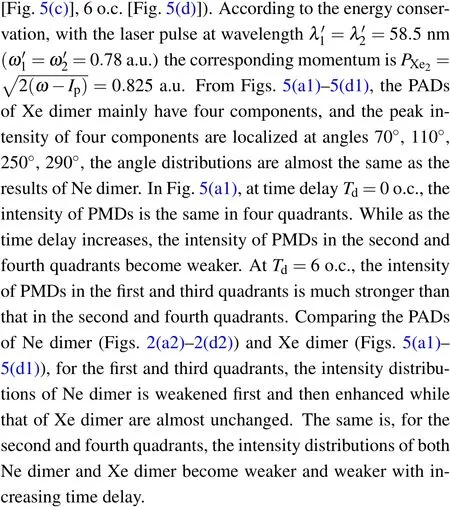
We also describe the photoionization process by the ultrafast photoionization model, the derivation process of Xe dimer is the same as the Eqs.(10)–(19)for Ne dimer,the initial state of Xe dimer is of gerade parity, the wavefunction is

The corresponding predicted results obtained from Eq. (26) are presented in Figs. 5(a2)–5(d2). Comparing Figs.5(a1)–5(d1)with Figs.5(a2)–5(d2), we can see that the same angle distributions are presented, but the amplitude of PMDs predicted cannot agree well with the results of TDSE sumilations. Similarly, we present the amplitude of PMDs simulated by TDSE for Xe dimer by the evolution of the electron wave packets in counter-rotating circularly polarized laser fields with different time delays in Fig.6.
In Figs.6(a1)–6(a3),whenTd=0 o.c.,fromt=7.5 o.c.tot=17.18 o.c.,we can see that the electron wave packets are located in four quadrants with same intensity, which agrees well with the TDSE simulation results in Fig. 5(a1). WhenTd=2 o.c., 4 o.c., and 6 o.c., the electrons are ionized along four quadrants and are mainly distributed in the first and third quadrants over time as shown in Figs. 6(b1)–6(b3), 6(c1)–6(c3),and 6(d1)–6(d3). Att=17.18 o.c.,there are more electrons distributed in the first and third quadrants than that in the second and fourth quadrants, which corresponds with the TDSE results in Figs.5(b1)–5(d1).Therefore,the evolution of electron wave packets also can be used to explain the amplitudes of PMDs for Xe dimer successfully.
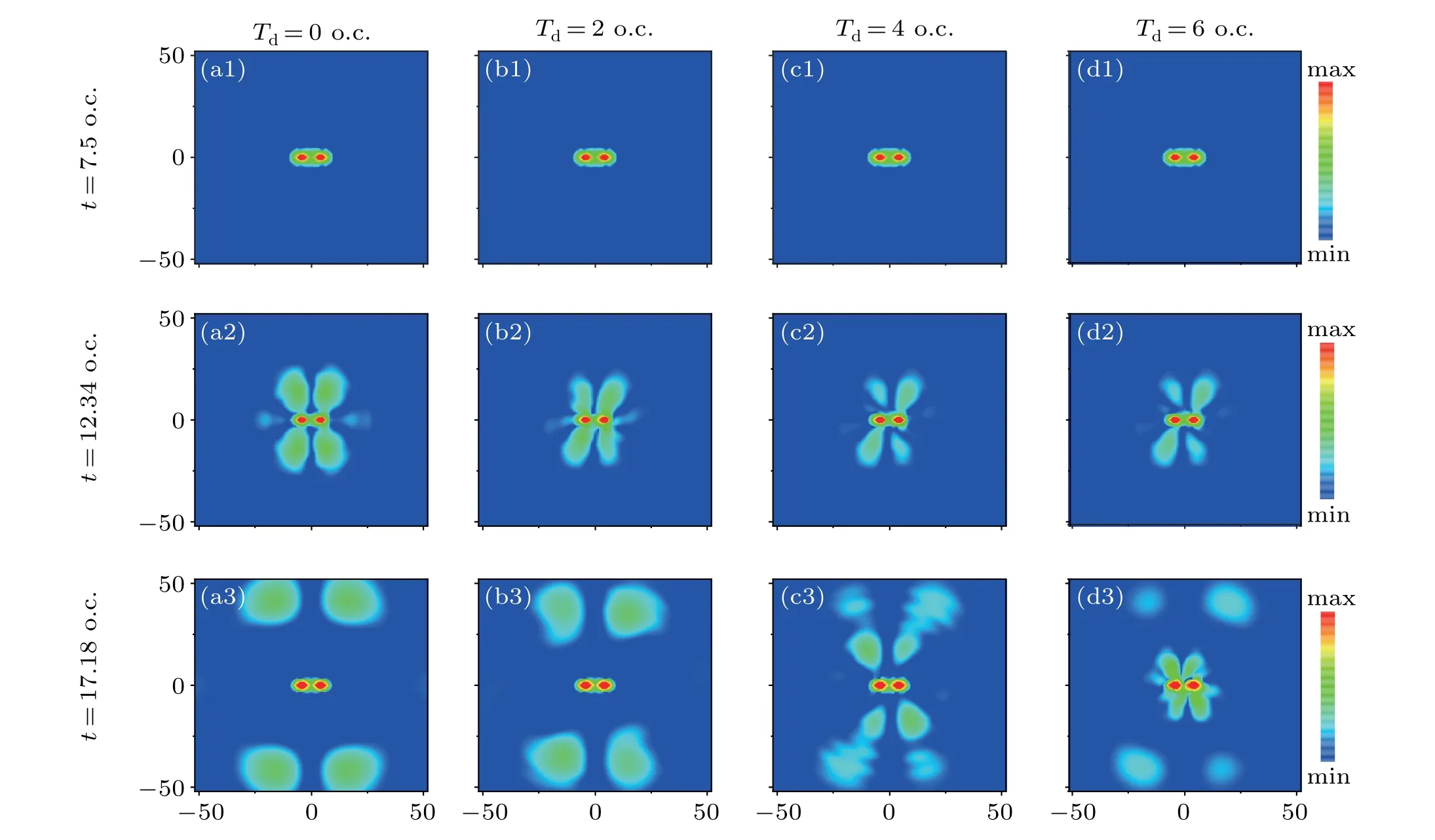
Fig.6. The electron wave packets for the Xe dimer at different times by counter-rotating circularly polarized laser pulses at wavelength λ′1=λ′2=58.5 nm(ω′1=ω′2=0.78 a.u.) with four time delays: [(a1)–(a3)]Td=0 o.c.,[(b1)–(b3)]Td=2 o.c.,[(c1)–(c3)]Td=4 o.c.,and[(d1)–(d3)]Td=6 o.c. The results are shown at three different times: [(a1)–(d1)]t=7.5 o.c.,[(a2)–(d2)]t=12.34 o.c.,and[(a3)–(d3)]t=17.18 o.c.
To compare the photoionization of Ne dimer and Ne atom,we investigate the photoionization of 2p-excited state of Ne atom with magnetic quantum numberm=-1 by timedelayed counter-rotating circularly polarized laser pulses.Figures 7(a)–7(d) display the PMDs of Ne atom with different time delays for the 2p-state(I2p-=0.793 a.u.) as the initial electronic state.
Figures 7(a)–7(d)show that the PMDs of Ne atom present two spiral arms at wavelengthλ1=λ2=20 nm (ω1=ω2=2.28 a.u.),and we can see that the PMDs are also sensitive to the time delay. The physical mechanism of electron vortices generation is the coherent superposition of photoelectron wave packets with time delay and different magnetic quantum number m. The valence electron in 2p-state can be ionized via following route by absorbing one photon from the first lefthanded circularly polarized laser pulse(E1)(|p,-1〉→|d,0〉)or the second right-handed circularly polarized laser pulse(E2)(|p,-1〉→|d,-2〉),as shown in Fig.8. Owing to time delay between the two pulses,a phase of e-iE′Td/¯hwill be generated in the final electron wavepacket by the first pulse, in whichE′represents the photoelectron energy.[44]The final superposition state reads

The interference of|d,0〉and|d,-2〉states generates a vortex pattern withC2rotational symmetry as shown in the Figs. 7(a)–7(d), and with the increasing time delay, the spiral arms become longer and thinner, which consists with the results in Ref.[45].

Fig.7.PMDs of Ne atom by counter-rotating circularly polarized laser pulses with time delay Td at λ1=λ2=32.5 nm(ω1=ω2=1.4 a.u.). The intensity of the laser pulses is I0=4×1014 W/cm2 (E0=0.107 a.u.) and duration is T =20T0 (T0 =2π/ω1)with τ =2T0 =2 o.c.,which are the same parameters as Ne dimer. Results are shown for four time delays: (a)Td=0 o.c.,(b)Td=2 o.c.,(c)Td=4 o.c.,and(d)Td=6 o.c.

Fig. 8. Single-photon ionization channel scheme for photoionization of Ne atom with the initial electronic state of 2p- by counter-rotating circularly polarized laser pulses.
The results of PMDs of Ne atom are obviously different from that of Ne dimer. We consider that the initial structure of Ne dimer maybe the reason of the absence of vortex patterns in its PMDs. Furthermore, the highly symmetry of the initial state of Ne atom may be an important reason for the appearance of the vortex patterns.
4. Conclusion
The photoionization of molecular ground state of Ne dimer and Xe dimer in counter-rotating circularly polarized laser fields are investigated theoretically. Simulations are performed on the Ne and Xe dimers by numerically solving corresponding 2D TDSEs. Our numerical results show the PMDs and PADs of Ne and Xe dimers are dependent on the time delays, which comes from the interference between coherent electron wave packets created by the time delay of two counter-rotating circularly polarized laser pulses. The ultrafast photoionization model and the evolution of the electron wave packets are adopted to well explain the results. In the comparison between Ne dimer and Ne atom, We found that the PMDs of Ne atom present vortex patterns. And we believe that the disappearance of the vortex patterns for Ne dimer can be attributed to the structure of initial state for Ne dimer.
Acknowledgment
Project supported by the National Natural Science Foundation of China(Grant No.12074146).
猜你喜欢
杂志排行
Chinese Physics B的其它文章
- Switchable terahertz polarization converter based on VO2 metamaterial
- Data-driven parity-time-symmetric vector rogue wave solutions of multi-component nonlinear Schr¨odinger equation
- Neutron activation cross section data library
- Multi-phase field simulation of competitive grain growth for directional solidification
- A novel similarity measure for mining missing links in long-path networks
- Effects of electrical stress on the characteristics and defect behaviors in GaN-based near-ultraviolet light emitting diodes
